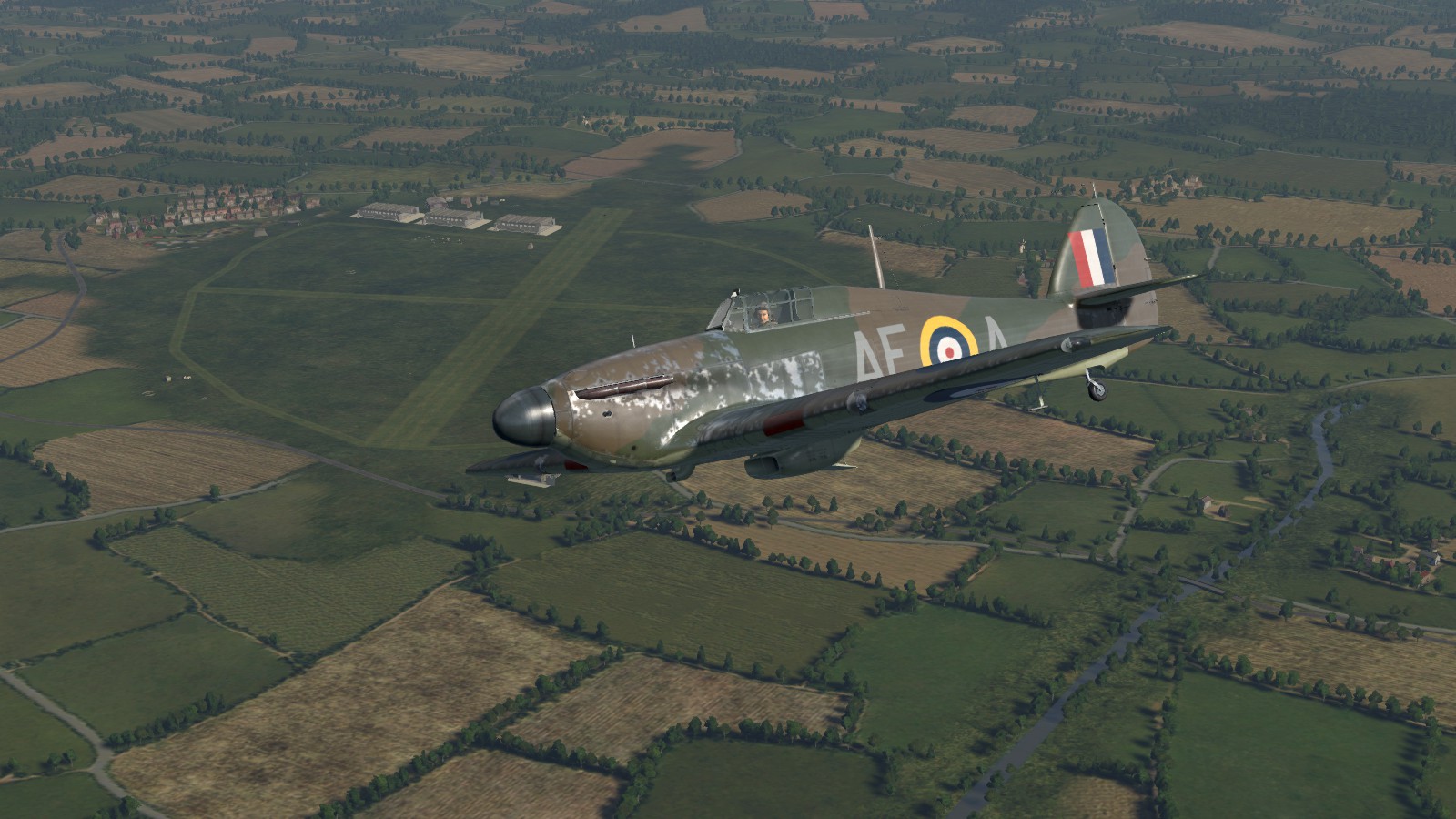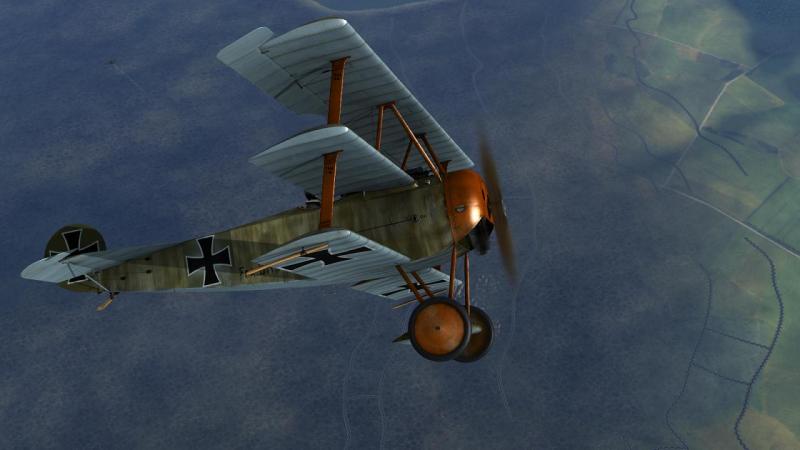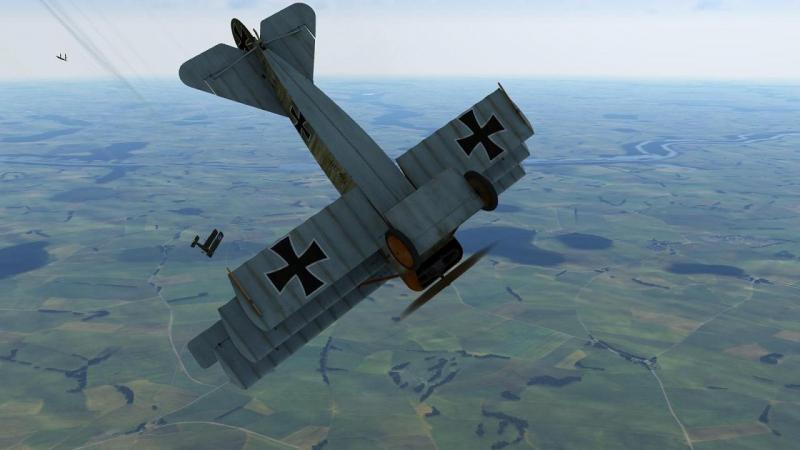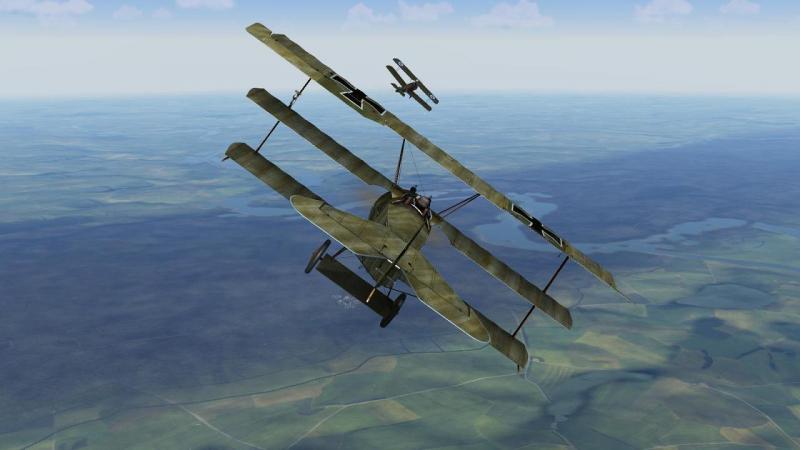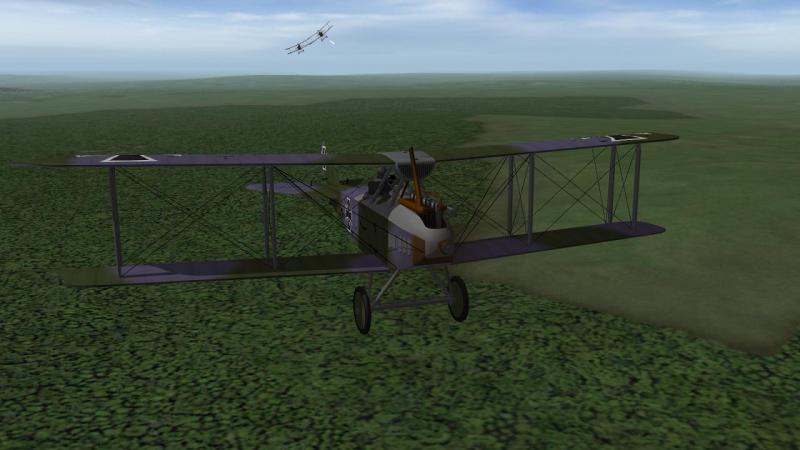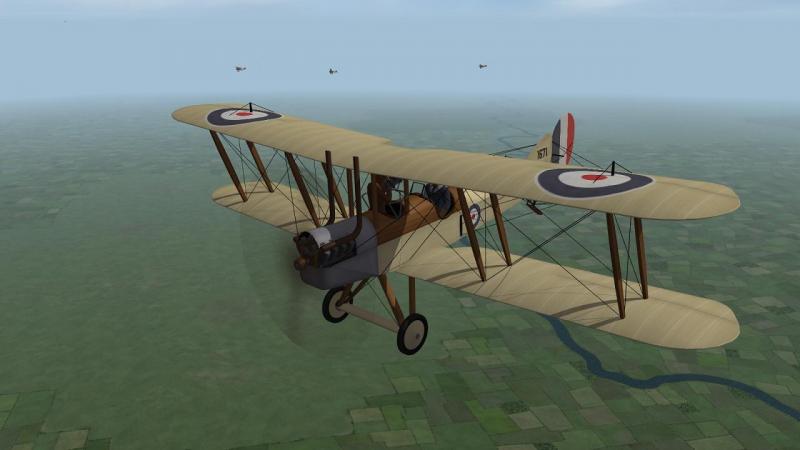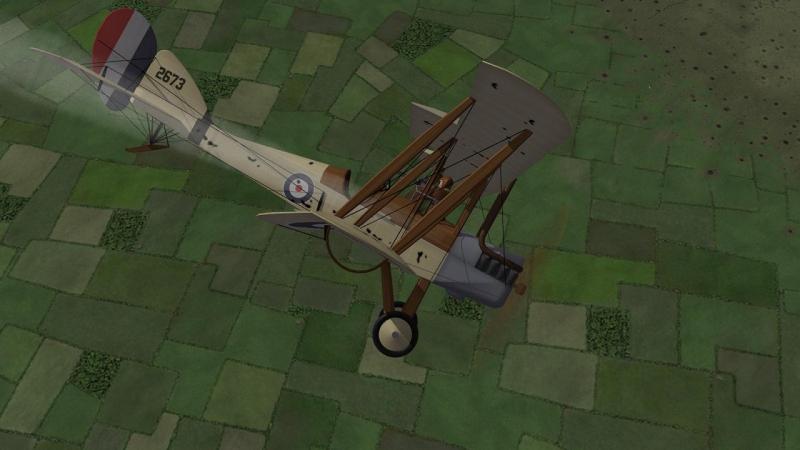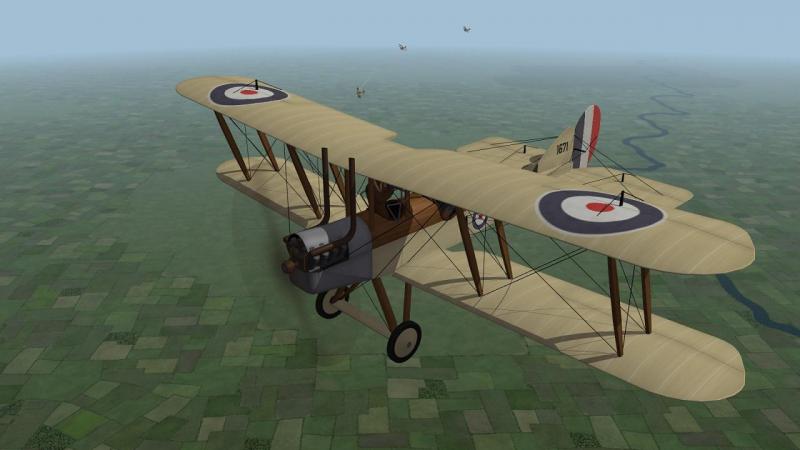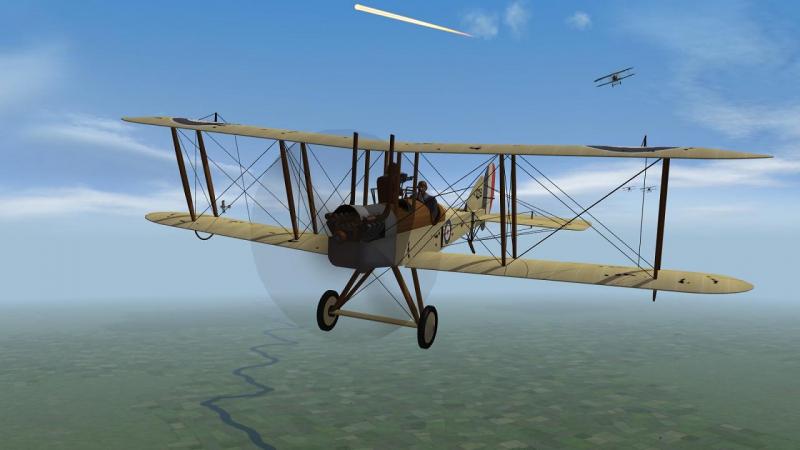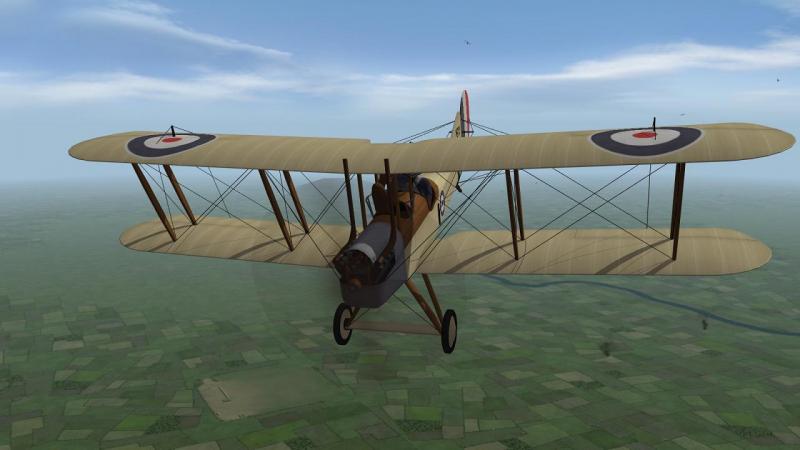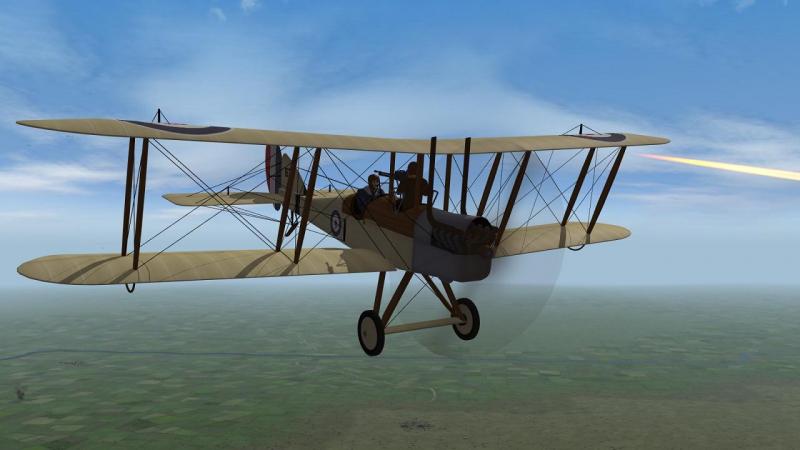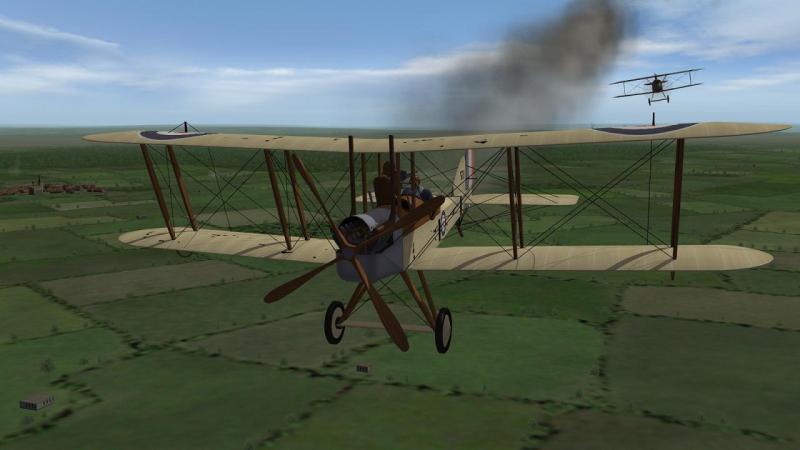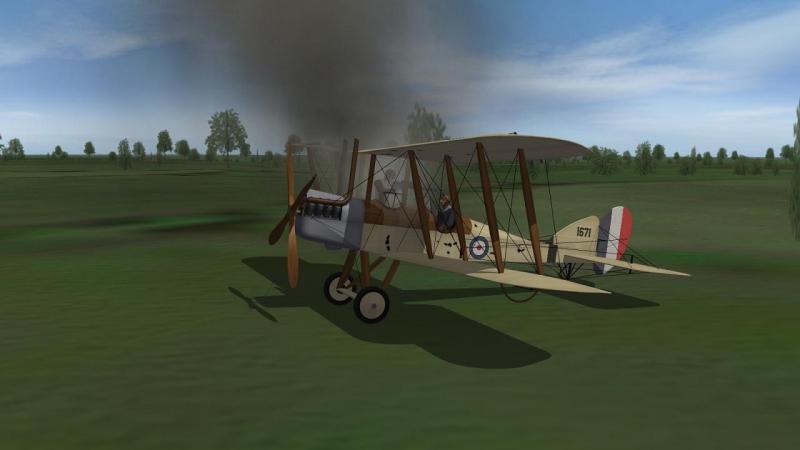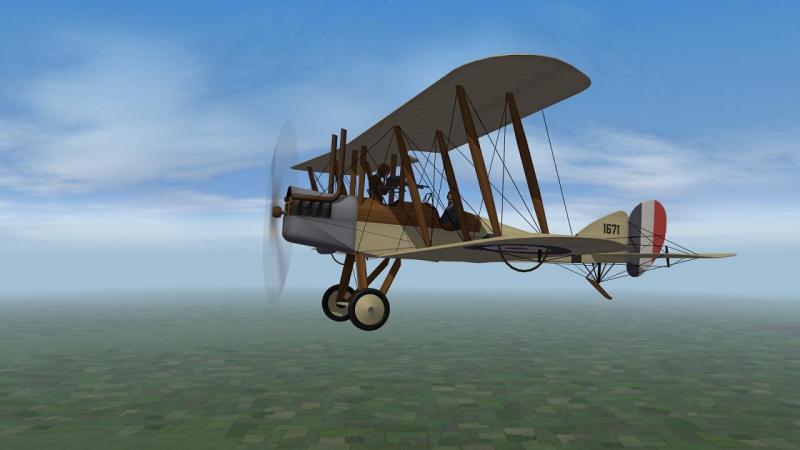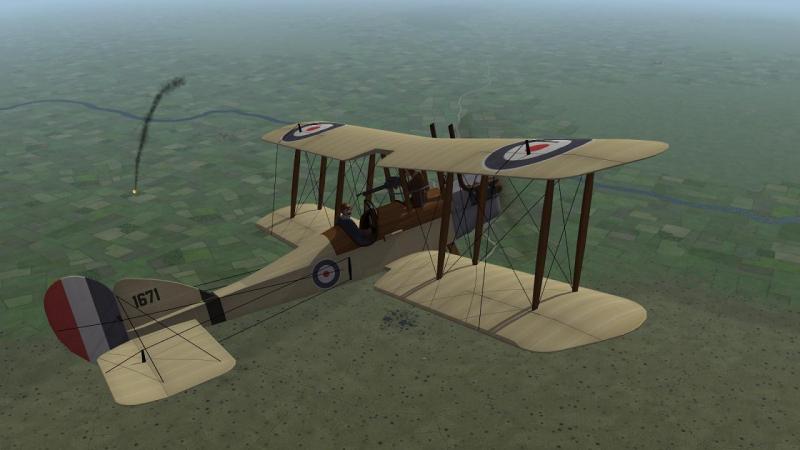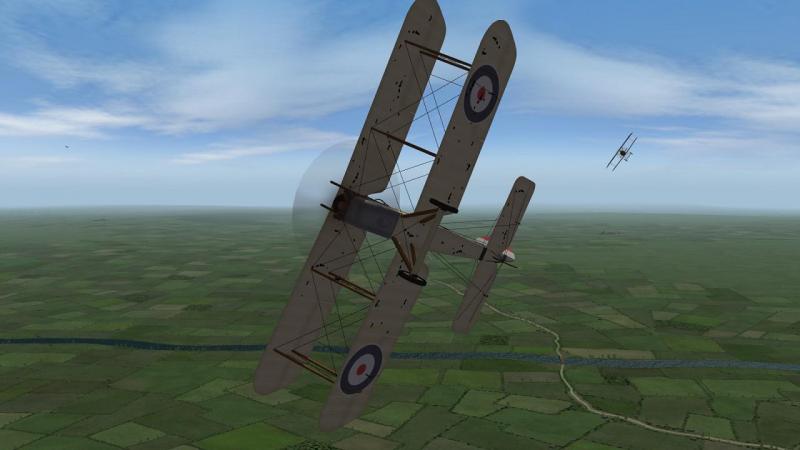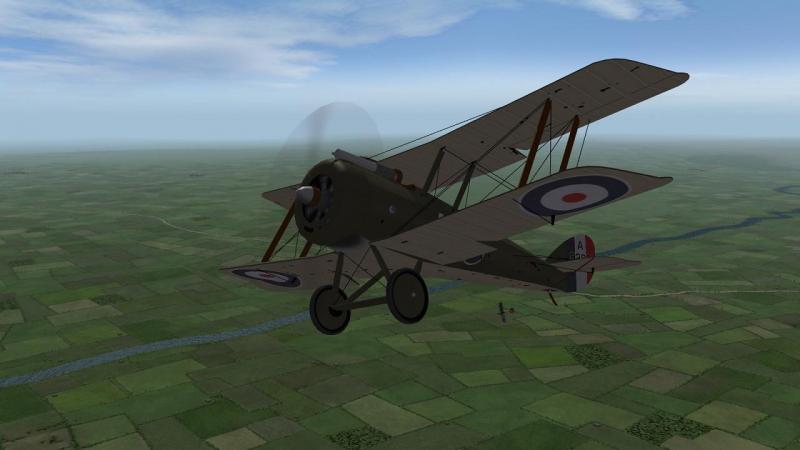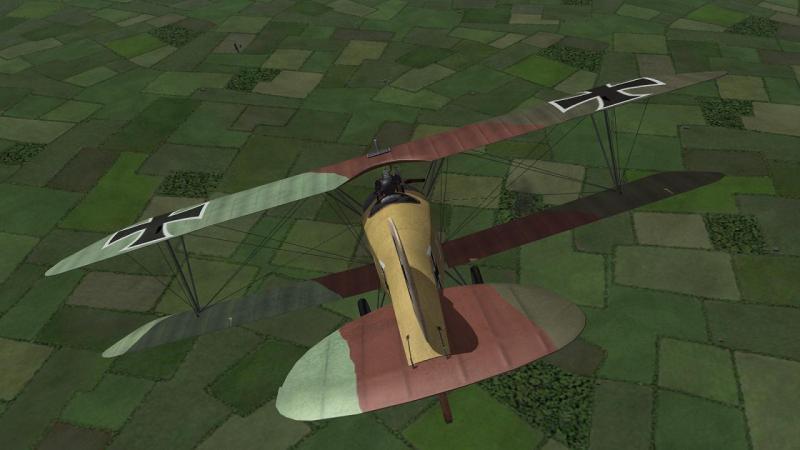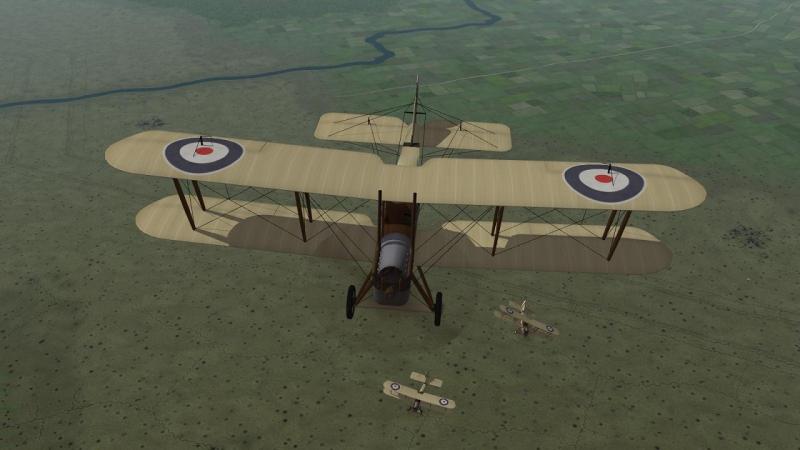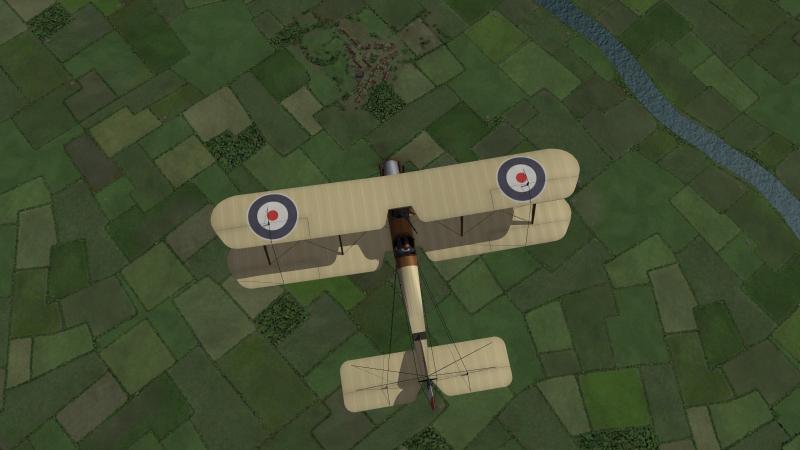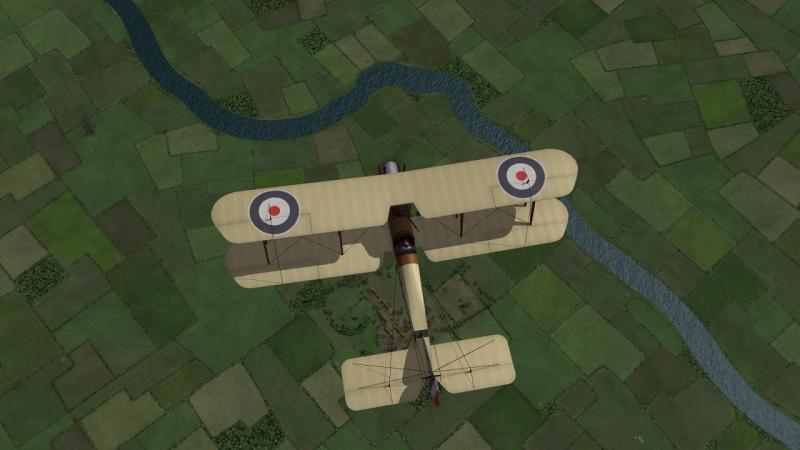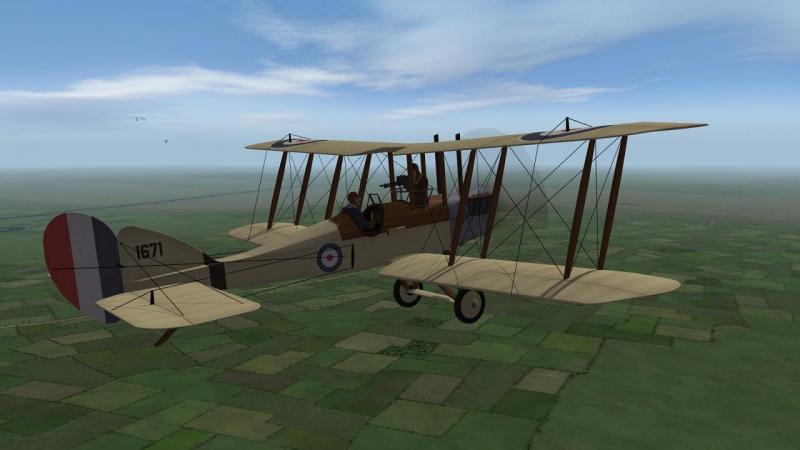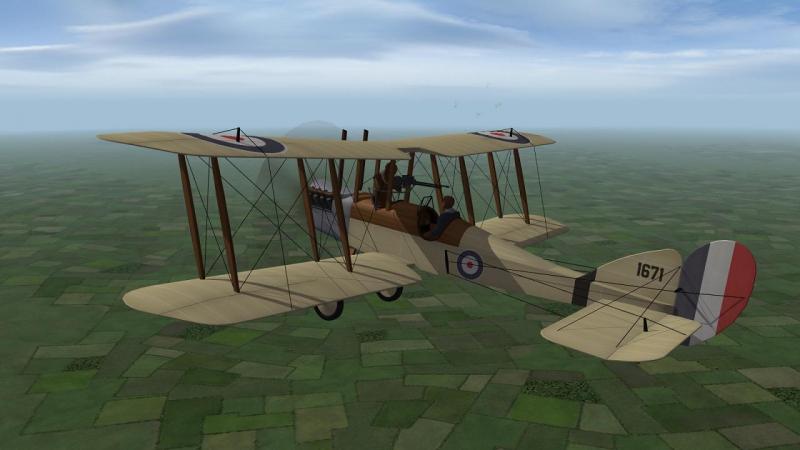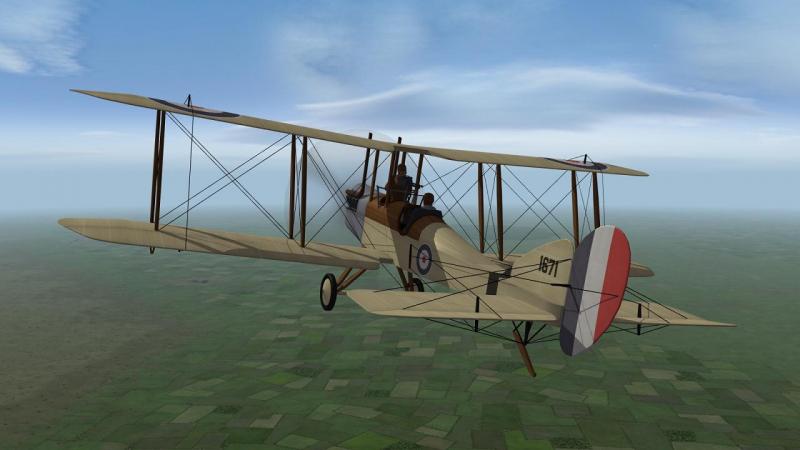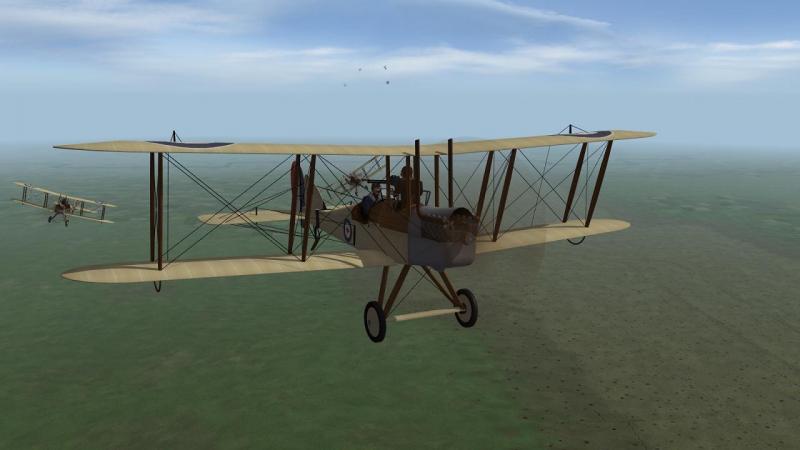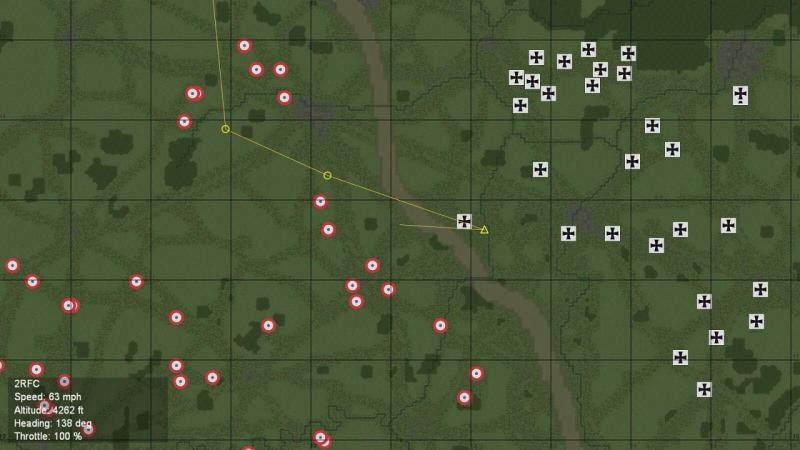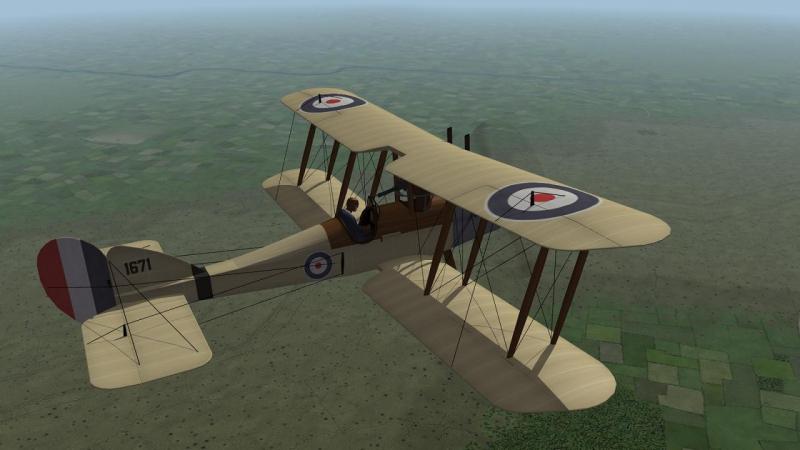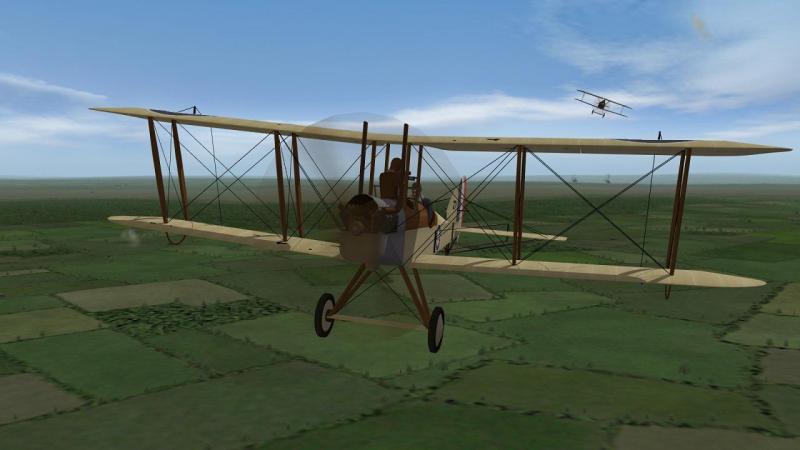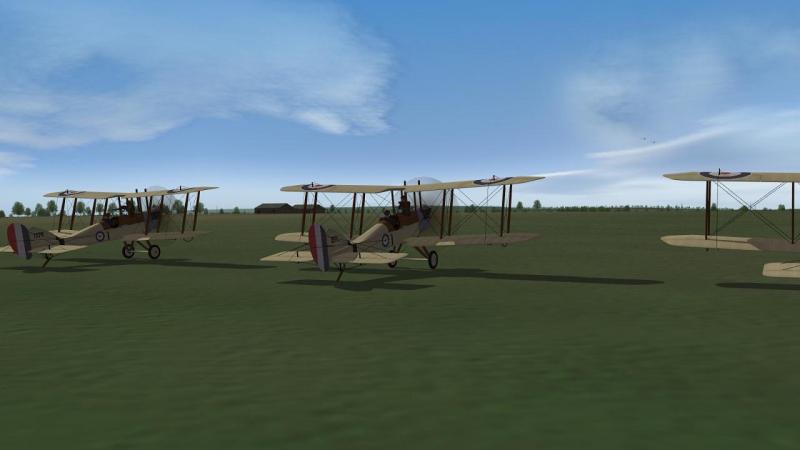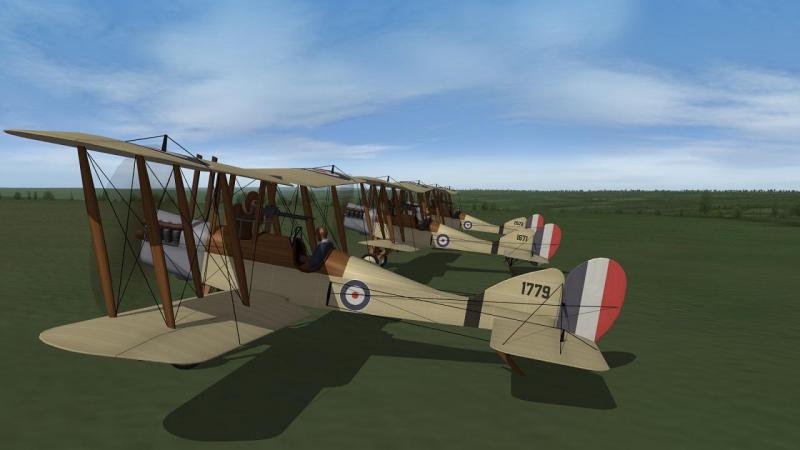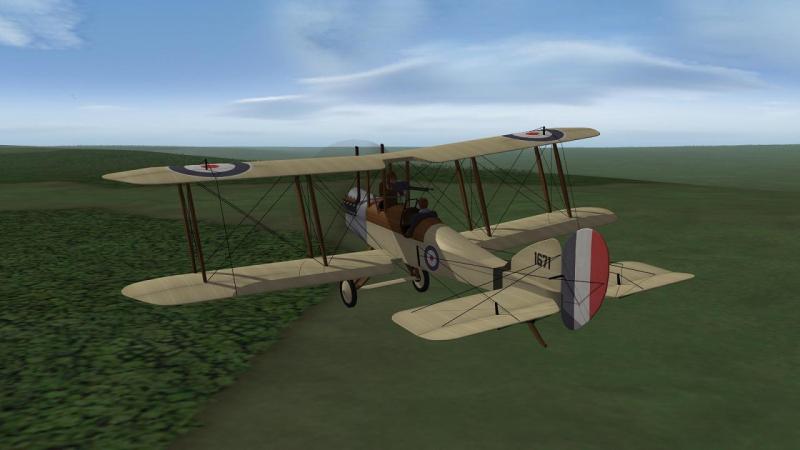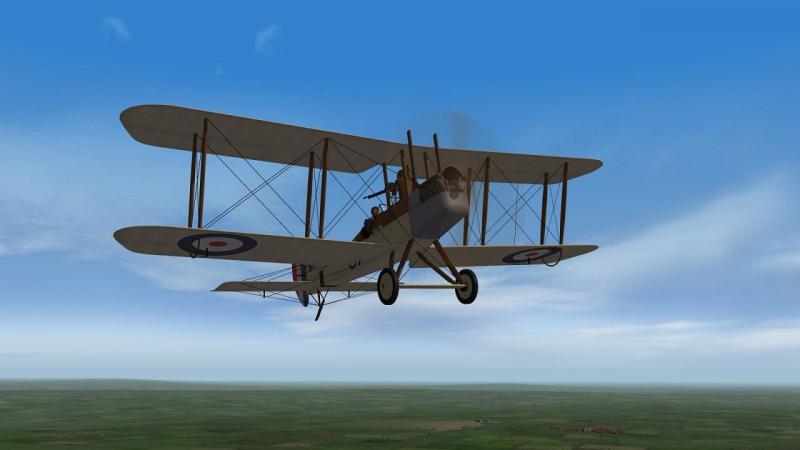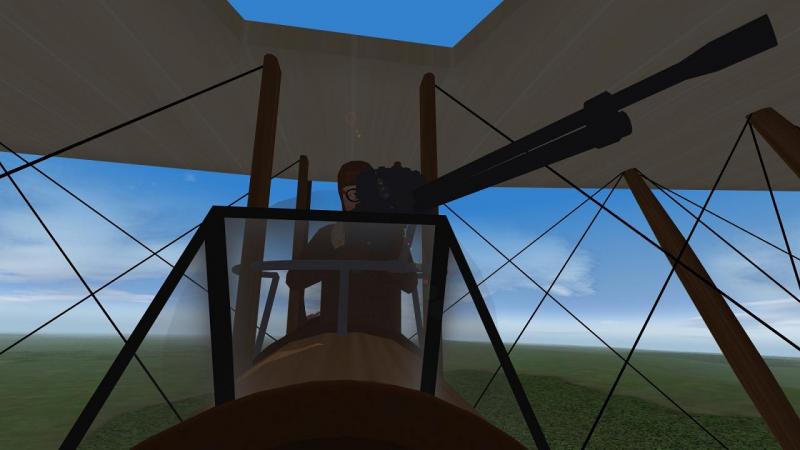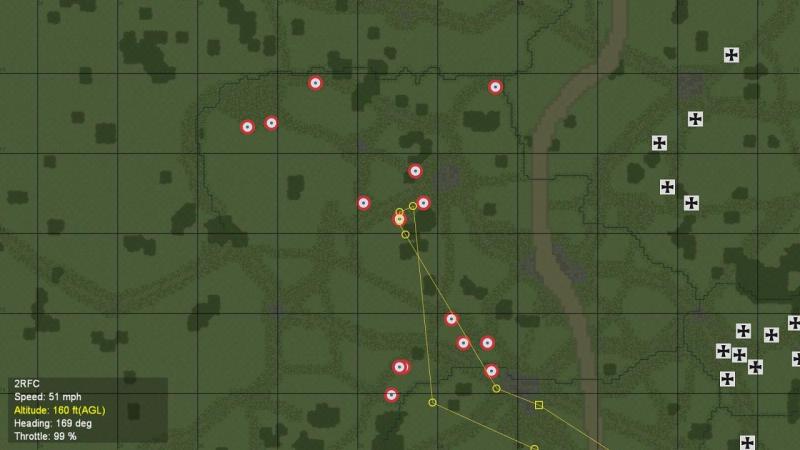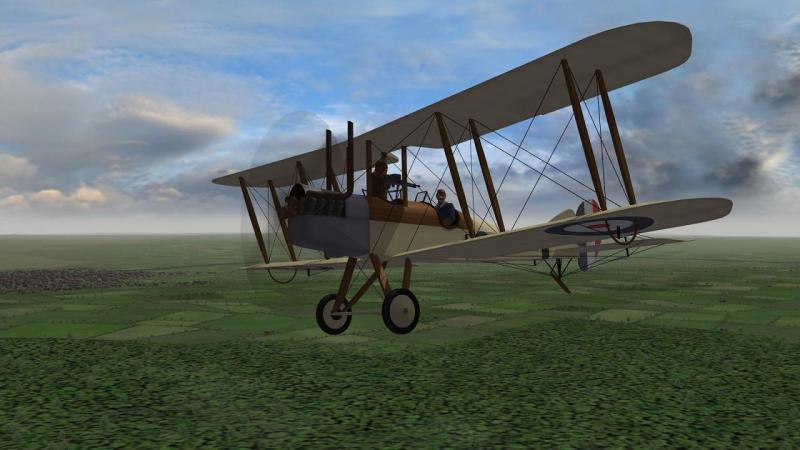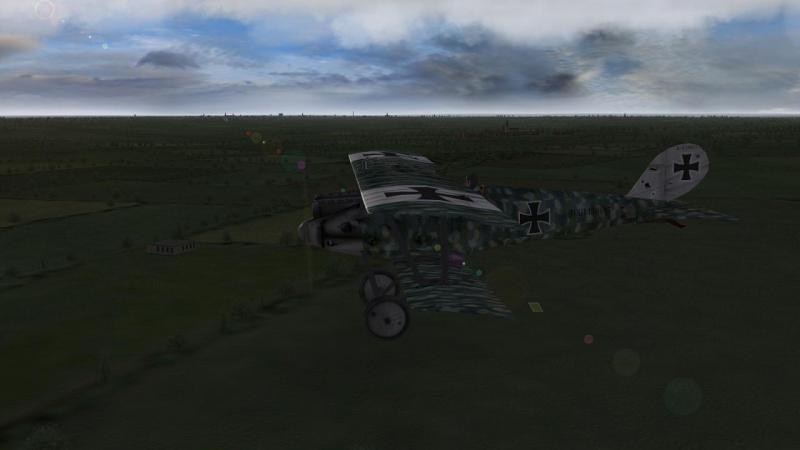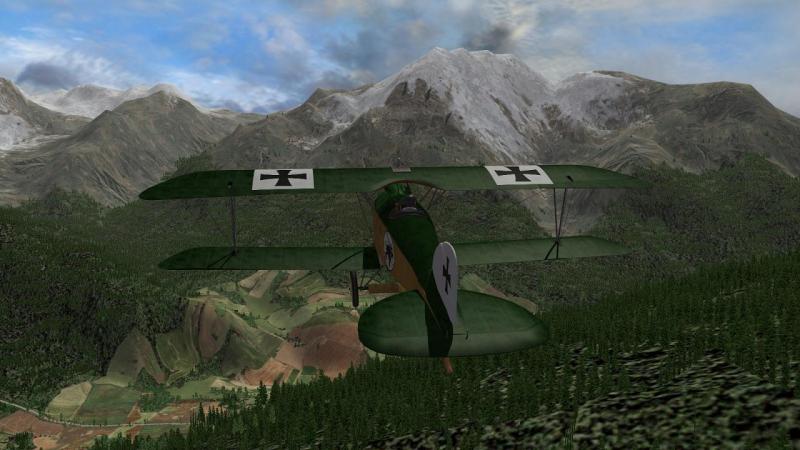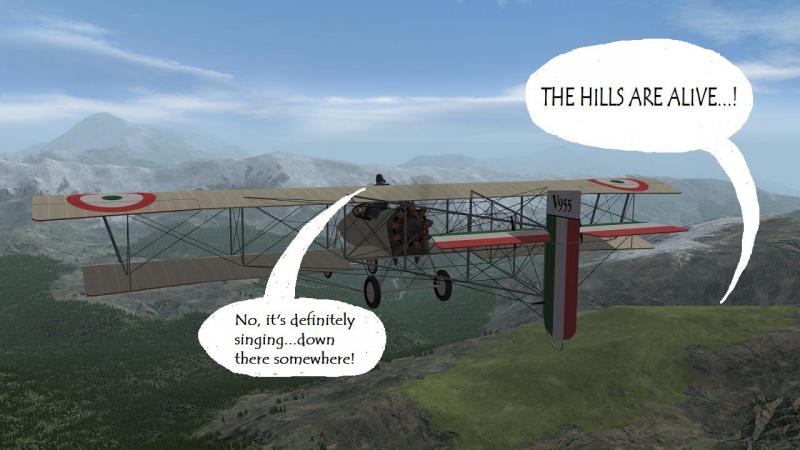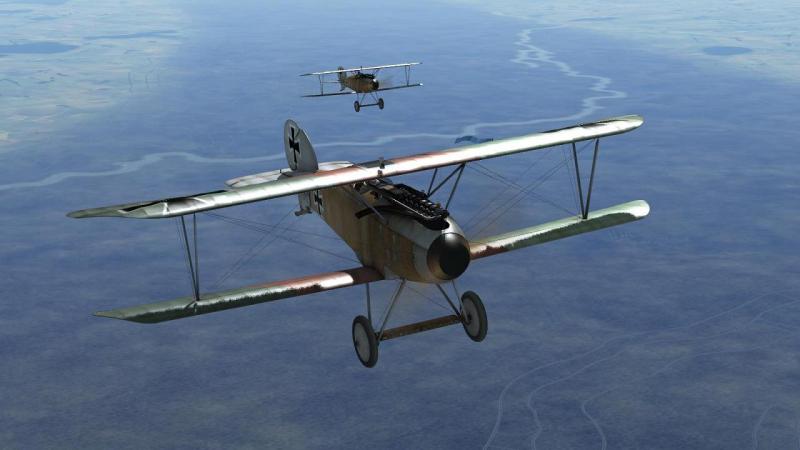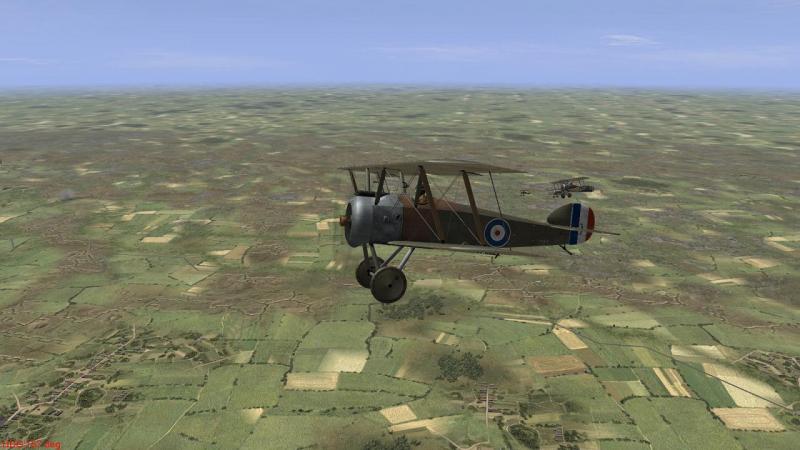-
Posts
3,749 -
Joined
-
Last visited
-
Days Won
7
Content Type
Profiles
Forums
Gallery
Downloads
Store
Everything posted by 33LIMA
-
First try-out with the latest version of Pat Wilson's Campaign Generator Fans of classic WW1 sim Red Baron 3d like myself will likely know Pat Wilson from his outstanding 'Western Front Patch' which added shed-loads of good stuff to RB3d - I still have a WFP install on my current PC! More recently, Pat has turned his attentions to Rise of Flight. The latter shipped with simple 'mission set' linear campaigns, later joined by a career mode (which is still nominally in beta!). To this, Pat added a new campaign interface and mission generator, which adds lots of features and for many, transforms the RoF Single Player campaign experience into something reminiscent of RB3d, whose campaign set the bar for these things so many years ago. PWCG has its own forum at RoF, where you can find out more, get the download links, and discuss the mod with others, including the developer: http://riseofflight.com/Forum/viewforum.php?f=394 The PWCG web page is here and includes help and documentation, as well as the downloads themselves; http://www.pwcampaigngenerator.com/WebSite/PWCG.html PWCG simply unzips into your RoF game folder and when you run it, lets you create a campaign pilot, chose his rank and nationality (if you choose 'US' this allows you to transfer from French or British services to the US Air Service after the latter takes to the field) and campaign start date, month by month. You then generate a campaign. After that, you generate one mission at a time. You can review the mission briefing with a map which describes route, waypoints and enemy & friendly air units known to be operating in the area. If you don't like the look of this you can scrub it and try again. This is similar to the option in OFF but doesn't just give you a different target/route. Don't feel like busting balloons today? Scrub that and try again, till you get a mission type that you prefer. You can also vary waypoints, review the squadron roster and select which pilots will accompany you (except the leader, if that's not you). You can then close PWCG and start RoF. Your generated mission will be there, waiting for you to fly, under the 'Missions' menu option. After flying the mission, you can go back into PWCG. You're prompted to give the number of any claims you want to make and can then view a RB3d-style animated mission debrief on the map. This describes results more like the Red Baron original and in a less cryptic way that OFF's equivalent: naming your wingman in entries for losses or kills for example. If you want, you can type free text into a mission report, for future reference or to impress the 'brass hats'. PWCG also lets you adjust many campaign parameters, not just simple ones like air and ground unit density. You can also apply for a transfer to a different squadron and take leave (=advance your campaign's current date). There is an interface mod available at the PWCG web page, that will put PWCG onto the RoF menu, improving integration. I'm not sure if it works ok with the latest versions of both PWCG and RoF. I started using PWCG on the recommendation of Barkhorn over at SimHQ while doing a comparative series of campaign mission reports for OFF, FE2 and RoF. I had been reluctant to do so as I (wrongly!) thought that working back and forth would be more hassle than I cared for, but I'm glad I changed my mind. Main factor here was that PWCG lets you choose a rank high enough to ensure that in most missions, you are the flight leader. This removes the chore of formation-keeping, takes away dependency on potentially-erratic flight-leader AI, and best of all, gives me the important and satisfying extra challenge of leading the patrol: navigating, watching out for activity and enemies and deciding what to do when we have a 'contact'. That's how I like to play all my sims so this is the biggest 'plus' for me. This is not a review of PWCG. I've barely scratched the surface of its capabilities; suffice to say it looks like an amazing piece of kit and I can well understand the general enthusiasm for it in the RoF community. Rather, I'm going to describe a campaign mission in the latest release. The change I was most looking forward to seeing (which came the previous release, IIRC) was more flak. One of the things I didn't like at all, beforehand, was the paltry AA fire. Naturally, I have long ago installed the mod which kills RoF's horrible 'environmental flak'. In a war where the sight of AA fire was perhaps the main indication of potential targets in your area - something well replicated in FE2 and OFF, but not in RoF - the presence of stray flak rounds just to add immersion was, in my view, a classic 'What WERE they thinking?' feature. But with 'environmental flak' laid to rest, I'd found that there was precious little 'real' AA fire. Much too often, planes that looked like obvious (if not priority) flak targets - and which I could see only using the excellent RoF view system - were not fired upon at all and so were not 'legitimately' detectable. This may have been compounded by enemy flights spawning rather close. Bad enough, but much worse if their arrival is not announced by the presence of nearby AA bursts. Getting no warning might be a fun extra challenge to some; but to me it's unrealistic if it happens nearly every time and it severely reduces the opportunity to do the patrol leader thing, where you spot an enemy flight in time to consider your options and make up a quick plan to deal with them. Preferably, with results like this: So having downloaded and installed PWCG 15.2, I was keen to see the difference and to get to the grips with the enemy, at least sometimes on my own terms, rather than just blundering into them. I was not disappointed! ...to be continued!
- 9 replies
-
- rise of flight
- rof
-
(and 1 more)
Tagged with:
-

Do I get WOFF? Need to know what AI is like.
33LIMA replied to Fortiesboy's topic in WOFF UE/PE - General Discussion
I'm interested in the answer to this too, tho I also place high value in the (to my eyes, best in breed) new cockpit, plane and terrain textures (the latter in particular are approaching photorealistic; amazing work) plus the better inflight map, the better integration between Manager and campaign, the extra flyables, the 'dot mode' visibility option which should reduce reliance on on-screen aids, mission improvements etc. On the AI front, the particular points that interest me most are: - do they AI fly formation any better? Specifically: - do they fly somewhat tighter formations? - do they no longer slide well wide, when the player leader makes a turn? - do they often fall below and behind a player flight leader, on the climb? - re two seaters and the former CFS3-style 'bomber tactics', do they now do more than maintain (rather wide!) formation and shoot back? Is their repetoire more varied? - how well do the new wingman commands work eg the 'split' command to avoid the AI following down a damaged player leader; and can you still order a general flight attack by hitting the A key a couple of times, as opposed to having to turn on the TAC, select a target before hitting 'A'?; - does the AI still 'rolleroaster' a lot, at low level? Pre-release videos seem to show a really major improvement in AI low-level behaviour, keen to know if this is sustained; - to what extent does the AI still tend to 'follow you home', even to the extent of German scouts flying a longish way into enemy territory? This is a frequent problem in sims and I have the impression OFF's new AI's more selective, situational thinking will reduce this 'target fixation', even if we players may take a while to get used to seeing flightsim AI that does not always robotically obey Lanoe Hawker's 'attack EVERYTHING' dictum. -

WOFF overpriced. Is it just me?
33LIMA replied to Blackadder33's topic in WOFF UE/PE - General Discussion
Value is in the eye of the beholder; each to his own. People are gladly paying $95 for access to the alpha version of IL2-BoS (10 flyable planes ultimately, if not at the outset) and consider that well spent. If you have to pay VAT on the $60 and are used to waiting and buying your sims after the release price has been reduced, and you need to upgrade your hardware to run it...if...if...if...WOFF may seem expensive...but an insult? As to whether it's good value, I don't think Steel Beasts (no harm in naming it) is an appropriate comparator as it's something of a special case. First Eagles and RoF are more appropriate comparators...and indeed OFF if you're considering 'upgrading' to WOFF. FE2 is very good value especially if you consider the many freeware planes and stuff; RoF the best value possible (or rather lowest cost, not the same thing) if you stick with the two free flyables, otherwise the costs come at your choice and rate. As for WOFF, the basic graphics engine has some limitations compared to some other sims, but out-of-the-box, you get fifty-plus flyable planes fully integrated into a great SP campaign system, exquisite new cockpit, aircraft and terrain textures, a shed-load of historical content, many improvements (and some brand-new features) compared to OFF, great music, and great support from the developers. Comparing the three current commercially-available WW1 offerings as packages, content for content, experience delivered for experience delivered, to my mind, WOFF certainly looks competitively-priced. -
A footnote in history... I forgot that I had intended to end this piece with a second RFC 'jingle' about ('jibe at' might be a better term) the much-maligned BE2c. So here goes. You can find these in several books that I've read over the years, but Arthur Gould Lee's 'No Parachute' is (like his follow-on book 'Open Cockpit') not just one of the best WW1 airwar memoirs ever written, but a good source for the words of little songs like this (sung to the tune of 'And They Called It Dixie Land'): Oh! they found a bit of iron what Some bloke had thrown away, And the RAF said 'This is just the thing We've sought for many a day'. Then they built a weird machine, Strangest engine ever seen, But they'd quite forgotten that the thing was rotten, And they shoved it in a flying machine. Then they ordered simply thousands more, And sent them out to fight. When the blokes who had to fly them swore, The RAF said 'They'll be all right. The bus is as stable as can be, We thought up every bit of it ourselves, you see.' They were so darned slow they wouldn't go, And they called them RAF 2cs! Service humour - don't you love it!
-

Additional info on Pfalz BI in the downloads section
33LIMA replied to keif149's topic in Thirdwire - First Eagles 1&2
Best just zap it, methinks. It seems not to be historical and Stephen1918's Fokker M7/BI fills the role (and is the one used in Gterl's new Italian campaign, whereas I think the 'BII' is not used in any campaign; none that I play anyway). So no real need to 'disarm' it. I know, I know, it's had to resist the temptation to have 'everything' but one can go too far...! -

Additional info on Pfalz BI in the downloads section
33LIMA replied to keif149's topic in Thirdwire - First Eagles 1&2
This is the one I was thinking of, the M10Z, you can see the resemblance; tho it doesn't have the inverted V struts above, like the model or the earlier Fokker, and of course the different fin and undercarriage: Ojcar is right of course, it is very unlikely these machines were ever armed with MGs, and a synchronised one never. -
Google 'WW1 plane crash' and view results under 'images'. Some are minor landing accidents or crash landings but others... I recall a pic in one of the Pen & Sword 'Airfield & Airmen' series that showed a Camel that appeared to have gone in vertically, into a field with some mud on the surface. It was just shattered, with the wings completely compressed right up to the leading edges where they hit. Just two lines of compressed wood & fabric sitting on the mud, with some crushed debris where the fuselage had hit, in the middle. Equally there are shots of planes which crashed and DID burn. A burst fuel tank spreading liquid and aerosol fuel over hot engine components... At the other extreme, isn't RoF notorious for a violent impact leaving a slightly-bent lawn dart? PS there's a lot more here if you've the stomach for it: http://www.earlyaeroplanes.com/archive5.htm
-
"The old lie; dulce et decorum est pro patria mori." (WW1 poet Wilfred Owen, the Latin translating as 'it is a sweet and fitting thing to die for the mother country') So far, so good. We had slipped across the Lines, made a single photo-run over the objective, and were now headed back the short leg to the Lines and friendly territory. Still keeping up with me were flight-mates Ward and Carey, who were my only escort. It was common practice at that time, at least in the RFC, for machines on a recce mission to be closely escorted only by some similar machines from their own squadron, relying for greater protection on any friendly 'offensive patrols' which might have been in the area. There were other aircraft not too far away, including a pair of SE5as. However, by the time I could have used their help, these two had been drawn down into a low-level chase with a Rumpler. Now, the only other aircraft in our area were the Hun scouts which had been involved in the air fight below us. Having evidently finished off their original opponents, they were now spiralling up after us. We were possibly half-way to the Lines when the first Hun slipped in behind Carey, who was just below and behind me. The Albatros wasted no time and was soon making good shooting. Whether in a selfless attempt to draw off the enemy scouts or in sheer desperation, Carey drifted off to my right, with Huns in hot pursuit. He didn't last long. First an aileron was shot away. I hoped he'd be able to make it, nevertheless; but the Huns kept shooting and soon he was going down. Next to be attacked was Ward. He was assailed from behind by three Huns, with their leader's tracers whipping past and into him. I didn't see him go. One moment he was there, the next time I looked back he had disappeared somewhere below. Now, it was just me and the Huns. I was out of friends and rapidly running out of options. What to do, what to do? A moment's hesitation; then I pushed the stick forward and dived steeply for our side of the Lines, which I had now reached. It wasn't long before the first Hun tracers were whipping past me. Back into friendly territory but with some very unfriendly people snapping at my heels, I steered towards a nearby airfield which a quick look at the map showed lay not too far off. As I'd hoped, a British AA battery opened fire on my pursuers. After some initial hesitation, my observer started snapping out short bursts from his Lewis. At this point I also ran out of altitude and had to level off. Some of my pursuers seemed to be hanging back, but their leader was undeterred and now rapidly caught up with me. Turning to avoid him would likely see me face-to-face with the rest of the swarm so I kept on my way, hoping that either my observer or the friendly AA fire would clobber the Hun behind me before he clobbered me. It was not to be. The Albatros fired another burst, there was a bang, and my propeller spun to a stop. Down I went, hoping to make it to earth with both myself and my precious virtual photographs intact. Sportingly - or perhaps unwilling to further hazard being shot down by our Archies - the Hun stopped shooting and broke up and away. Unsportingly, my observer let him have a final burst from the Lewis, as he did so. Fortunately, this provoked no retaliation and I managed to plonk my kite down in a convenient field, somewhat the worse for wear but still in one piece. Well, that was that. We'd accomplished our mission, which was rated as a 'success' in the debriefing screen. Militarily perhaps; but it didn't feel very successful, bought as it was at the cost of two crews lost. Perhaps we'd been unlucky. We nearly got away with it, and might have done so had the air fight below us gone on a bit longer, or had a friendly patrol arrived on the scene. In not waiting for the skies to clear before heading across the Lines, I had gambled on one or both of these things happening. I'm not sure to count the result as a win or a loss but it was an expensive result. So concluded my first mission in Stephen1918's new BE2c. As an experience, it was at turns thought-provoking tactically, exciting, nerve-wracking and intense. If you don't fancy trusting your virtual life to 'Stability Jane', the new BE will make a fine target! It looks the part, my only observations being that the lower lip of the pilot's cockpit coaming could perhaps be a scale inch or two above the upper longeron and the control wire from the kingpost to the upper and then lower ailerons could be a bit further forward, instead of near the trailing edges. She's otherwise at least as good a 3d model - much better, in my view - as the OFF and WOFF BE2cs which have excessive wing overhang, lack some prominent landing and flying wires and have a very unusual set of extra bracing wires between the outer interplane struts and upper wing tips. WOFF has some new armament variations including the flexible Lewis the OFF version sadly lacked and includes an excellent 'Strange mount' for the gun. As with other FE aircraft, the dynamic shadows and good aircrew animation really help bring this new BE 2 to life. The factory-finish clear doped linen 'skin' is very good indeed, with subtle seams and stitching and the subdued RFC roundels look most realistic. As for flight models, the FE BE2 rolls left due to torque so can't be flown entirely 'hands off' and when diving her for home I found she needed quite a bit of forward stick deflection to get her nose down and keep it there. Speed and climb seem much as you'd expect. Undoubtedly, she's a delightful and much-needed addition to the FE planeset and one I'll be returning to often. The new BE is available here: http://combatace.com/files/file/14468-raf-be2c/ The 1917 part of Ojcar's 'Armchair Aces' campaign - for now you have to edit two campaign data files in Wordpad to get the new BE - is available here: http://combatace.com/files/file/12810-armchair-aces-1917/
-

Additional info on Pfalz BI in the downloads section
33LIMA replied to keif149's topic in Thirdwire - First Eagles 1&2
Apart from its tail, which is typical of early Pfalz types, this machine appears identical to the Fokker M10Z. Thetford and Gray's 'German Aircraft of WW1' says that 'a small number of this type was supplied to Austro-Hungarian air force, who designated it BII'. Stephen1918 makes reference to this on his download page for the single-bay version, the Fokker M10E (BI in Austro-Hungarian service): http://combatace.com/files/file/13103-fokker-m7bi/ It was not uncommon practice in Germany for planes to be licence-built by other companies who sometimes fitted different components, including tail surfaces. -

Verdun needs some real forts.....right?
33LIMA replied to quack74's topic in Thirdwire - First Eagles 1&2
Looking really great! Shame on you, for dropping bombs on it...tho the cratered version is most effective! -
Theirs not to reason why, theirs but to do or die... At this point, just as I was about to wheel left and run into Hun-land and over our recce objective, things got complicated. Specifically, AA fire broke out, in two directions. Ahead and below, some dark bursts denoted enemy fire. Of rather greater concern, the skies to my left, which had looked to be clear, were now also stained with the bursts of German Archie. I hesitated half-way through my turn towards enemy territory. The activity to my left was obviously the greater concern, and as I watched, I could see the shapes of several aircraft wheeling in a dogfight, rather below our level. Before too long, a dark streamer of smoke stabbed down earthwards and a bright orange fireball on the ground marked the end of one of the combatants. The AA fire further south was actually directed at this fellow, though all I could make out from my height was a single aircraft flying north along the trenchlines quite low, tracked by Hun Archie. As for the air combat over Hun-land, this consisted of a battle involving some DH5s and at least one other BE2, none of which seemed to be faring too well against some eager-beaver Huns in V-strutted Albatros DIIIs. If I'd had any sense, I would have drawn back into friendly territory, gained lots more height, and come back later when the neighbours were no longer at each other's throats (and liable, some of them, to make a grab for mine). But the objective seemed such a short, short distance away. The air-fight lower down might tie up the enemy scouts while I made my planned dash across, I thought. Then I thought some more....right! That's it. We're going in. Hell for leather, Devil take the hindmost and all that sort of thing. Over we went, as fast as we could...which wasn't very fast. Not in a BE. The air fight went on below us, claiming at least one further casualty whose crash I saw. Steadily, the trenchlines fell away below and behind us and the target village drifted closer...and closer...and closer. Finally, keeping her nice and level, I overflew the village. Whatever virtual photographs we were able to take in that one pass, I was not going to tempt fate by attempting any more. I swung around hard left and ran for home. My flight-mates, although now somewhat lower, gamely followed, as if their very lives depended on it...as indeed they did. ...to be continued!
-
Onward and upward... Having quickly arrived (courtesy of the 'next encounter' aka 'warp' key) at the last waypoint before our objective, at which point I planned to review the situation, it became evident that some reasonably hasty re-planning would be desirable. There were two reasons for this. The first issue was that I had come out of 'warp', as to be expected, at the mission's programmed height. At 3-4,000 feet, this was a tad low. So I decided to fly further south and gain some more height, before turning left, crossing the Lines, and running into my target. The second issue, you can see in the screenie below. Looking left into Hun-land, I could see Archie at work - a cluster of puffs of AA fire, roughly over the trenchlines. They looked to be darker bursts and thus German fire directed at an RFC mission. I wasn't entirely sure at that distance but in any event, the sight of this activity, which was liable to draw more aircraft to the scene of the action, confirmed me in my decision to head further south over friendly territory. As we flew on, looking three-quarters right, I saw some more AA fire, this time well over our side of the Lines, denoting the presence of a threat - Huns! I hoped they would be two-seaters, perhaps on a recce mission like our own, and not scouts. The latter were, I reasoned, less likely to favour making sight-seeing trips into our hinterland. But one never knew quite what the wily Hun might be up to. So I kept a careful eye in the direction of this AA fire, ready to run for it, if those bursts showed any sign of tracking in our direction. Fortunately, they did not. Looking left again, the AA fire in that direction seemed to have died away. But I was not yet as high as I wanted to be before turning into harm's way. So I continued to lead the flight onward and upward, fretting at my machine's slow rate of climb but gradually getting up towards my desired minimum altitude of about five thousand. Looking back, I could see that my flight-mates were now weaving about a bit, but keeping up quite well. Back over the trenches, the AA fire I first spotted had erupted again but had drifted well astern. I was not unduly worried about it or whatever it portended. As I flew on, I looked for landmarks, orienting myself by checking back and forth between in-flight map and what I could see from my aircraft. I picked out on the map two reference points from which I would judge my left turn - a roughly circular wood a short way 'inland' and level with this a larger, kidney-shaped one whose long side ran along our side of the shelled area. 'Reference point - half left, three miles - kidney-shaped wood - will be known as Kidney Wood!' I told myself (the old infantry training dies hard). Even though my objective now lay almost due west across the Lines, I decided to gain a little more height on my southward track, then turn in once I'd reached Kidney Wood. On we went. Peering left into Hunland, I could make out the enemy airfield near our objective. And I could see the target itself, a modestly-sized village near a bend in the river, some way north of a road bridge. You can likely make it out in the screenie below; it's just ahead of and slightly above my port upper wingtip. Not long now, I told myself...but the best-laid plans of mice, men and BE2cs gang aft awry, as the great Scots poet would doubtless have said, had he flown the type. Matters were about to take an unwelcome turn. ...to be continued!
-
Hi von Oben i've not attempted any 'scientific' analysis of aircraft visibility. But whatever the numbers are, I have always been struck by the difference between OFF and FE, manifested as the former giving me significantly less time - flying with minimal visual aids - from detecting a threat to being able to see enough about its composition, bearing, height and course, to decide on a suitable response. RoF is similarly not as satisfactory as FE, tho for some reasons that are different (eg sparser flak coverage, tho recent PWCGs are doing something about this). WOFF's IL-2-like 'dot mode' for longer range aircraft may help improve the situation here, as it was presumably intended to do. It's not just about aircraft level of detail models or rendering range. How flak is portrayed makes a big difference; maybe the biggest. In FE, flak is relatively closely grouped around the point of aim (unlike OFF); is visible at quite long range and produces nice clusters of bursts (unlike RoF); and doesn't disappear and re-start if you pan away (unlike OFF). RoF's flak coverage seems significantly more sparse than either FE or OFF so enemies that should often (IMHO) attact AA fire too often (IMHO) don't and thus escape observation. I haven't played DBW 1916 often enough to form a view of where it falls on this scale; possibly towards the 'better' end. Re RoF, when doing single player, there are some things you need to be online, to be able to do. Career beta is one of them, I believe. I'm not sure about Pat Wilson's Campaign Generator which is the main alternative and what I've been using, mostly; I think a connection is only needed to download it, not play. I log in online routinely anyway so haven't noticed. The post by Trooper117 here is right I think: http://riseofflight.com/forum/viewtopic.php?t=30702
- 46 replies
-
- first eagles
- over flanders fields
-
(and 1 more)
Tagged with:
-

Towns, villages as targets with damage
33LIMA replied to quack74's topic in Thirdwire - First Eagles 1&2
Hey, I hope somebody got that Gotha's number - that looks like a war crime there! Looks great and looking forward to the new Verdun, International Military Tribunal or no... -
Meanwhile, back on the Western Front...! First installments in my campaign mission report on the new BE2c are up: http://combatace.com/topic/81025-fokker-fodder-flying-the-new-be2c-in-first-eagles/ Have to finish this tomorrow...need to get some kip now...zzzzzz
-
The mission begins At the campaign creation screen, as usual with FE (FE2 in my case), I had the choice of flying with a range of operational squadrons from either RFC or Luftstreitkrafte. I reviewed the available RFC units and chose No. 2 Squadron. From its number, it was one of the Corps's senior units and one of a number still flying the BE2c in this campaign. I kicked off the first campaign mission. It was May 1st, 1917; and we were at Bruay aerodrome, some way north-north-west of Arras. Our mission was a reconnaisance to a marked but unspecified village a few miles behind the enemy front lines. This village was south-east of our airfield, about half as far again as Arras. I went to the squadron roster, which had a realistic number of pilots at realistic ranks. There were few NCO pilots in the RFC; most were lieutenants, some captains, with squadrons generally a major's command. FE reflects this nicely and the names don't sound like they came out of a modern 'phone directory. I decided to take two other pilots with me, and picked them from the bottom (less experienced) end of the roster, as I usually do. I studied their names for a bit; these were the men I would be leading, and whom I would try to bring alive with me, through the campaign. While this little bit of squadron-management isn't right for the flight leader role in which FE casts the player, it does produce the means by which you can fly with a flight whose members you know and for whom you feel some responsibility. Likewise flying as leader from the start means you're never kicking off as a novice player. But then, we mostly aren't novice flight simmers, are we? Besides as leader, not only do you not cast yourself at the mercy of the vargaries of an AI flight leader apt at times to hit typical AI limits, but you save yourself the chore of formation-keeping. Best of all, you get to make plans before the flight and tactical decisions, during it. For me, FE's way is best. Simple, but very effective. Before finally starting the mission, I checked out my route in the planning map. This showed the front line as having pushed east from Arras, a nice touch reflecting the small gains made in the battle of that town's name, over which conflict 'Bloody April' was fought. The assigned route had a few of the usual 'dog-legs' but was not too far short of direct. I don't recall our assigned height, but it was low, maybe three and a half thousand. I wasn't worried as I could vary this to my liking; I would likely fly at about five thousand feet, which is a realistic height for a WW1 photo-recce mission. To accomplish this I would fly across my objective at least once at about that height, perhaps twice, going out and coming back, if tactical conditions permitted. They did not, in the event. Looking at my allocated route, I was concerned about the way it crossed the Lines into Hun-land on a diagonal, some way short of the objective . This left me with quite a bit of my run-in over enemy territory, where we would be exposed to both AA fire and attack by enemy aircraft. So I dragged my 'initial point' - the WW2-era term FE uses for the last waypoint short of your target/objective - back across into friendly territory, to a point behind the British reserve trenches and somewhat north of level with my objectve, as it were. My plan was that, on reaching the 'initial point' I would review the situation and if all seemed clear, turn left and make a dash (to the extent that a BE can really dash!) across the Lines to the objective, then straight back over. This would leave me over enemy territory for the shortest possible time. Plan made; off to the flight-line. And here we are. As usual FE gives each plane distinctive markings; in this case, serial numbers on the fin, as in real life. No fancy skins are yet available for this new BE2 - just the one I got - plain doped linen - or one with brownish PC10 upper surfaces. The latter would have been more appropriate for a 1917 machine and I could perhaps have selected it pre-flight, but last time I tried it my 'loadout' screen crashed the game (some installation error on my part somewhere I'm sure; all else works fine) so I didn't bother. That's me in the middle, flying 1671. Stephen's BE is a fine bird; unlike the BE2c in OFF/WOFF, it isn't missing some prominent bracing wires and it benefits from the self-shadowing and decent aircrew animation that comes as standard with FE/FE2. RoF has this of course as well as even better visuals...but it doesn't have a BE....yet, anyway. The new FE machine has the larger fin with a rounded leading edge. These were introduced on later-production machines - from mid-1916 or thereabouts - to increase directional stability, I believe. Stability was just the thing for a 'working aeroplane' flown by hastily-trained crews and the BE appears to have deserved its alternative nickname, 'Stability Jane'. It's a bit unfair, though, as many have done, to criticise her for being unable to manouevre with fighter aircraft, designed as such. An observer in the rear with a better field of fire would have been rather a good idea, though. Off we went. speaking of observers, BEs were fitted with a wide range of mounts for the observer's Lewis Gun. Stephen's is a compromise, which gives the gunner a relatively wide arc of fire, which they could get in real life by switching the gun between mounts. To my eye, it's a sort of combination between the so-called 'goalpost' (crossbar) mount between the rear centre-section struts and a 'candlestick' mount on each side. In the model, these are joined up to give a roughly semicircular ring. However, as the plane's readme says, the aircraft comes with a restricted arc, roughly comparable to the rear mount only, but it explains how you can easily hand-edit a file to increase this. One thing I will definitely be increasing is the pilot's arc of vision to the rear - at the moment you hit a hard stop at about 60 degrees each side of straight ahead. This leaves a massive blind spot to the rear. I will increase this arc so I can look back over my own tailplane. I was soon airborne. The tail seems to come up of her own volition quite soon, but she needs time after that to allow the speed to build up. Otherwise, she unsticks in what feels like a semi-stalled condition, where you're having to keep the elevators up quite a bit to keep the nose level. Best strategy seems to be a long takeoff run followed by a very shallow climb out, to let the speed build up before you really begin a serious climb. The AI seem less restricted and often pull up quite steeply for a bit, after takeoff, not uncommon in FE. There was a pair of unidentified aircraft passing fairly low near us as we took off, but they were not attracting any AA fire, did not react to us, and were certainly 'friendlies' (you can see these two in the 'flight line' screenshot at the top of this post). Here's the cockpit and the view ahead. Although these views are probably somewhat zoomed-out, it's true that your observer doesn't block your view ahead too badly, and though he won't sit down as observers do in RoF (too much!) he's nicely animated, scanning for targets as best he can. And here's most of my route, shown in the in-flight map, which is what you see in-game and has no labels. My 'initial point' is the yellow box on the eastern side of the (grey) town - Arras possibly. My objective is just off-screen; as I planned it, not far behind the north-south brown strip that represents the 'shelled area' of No-Man's Land. As the leg up to my re-positioned 'initial point' lay well on my own side of the Lines, I used the 'next encounter' aka 'warp' key to save a bit of time. We came out at the 'initial point' itself, well positioned, as I had intended, to assess the situation before making the shortest possible run-in to enemy territory and our objective...and hopefully, back out again, with our precious photographs. ...to be continued!
-
First outing with Stephen1918's latest addition to First Eagles/FE2 Of the three current WW1 airwar sims, one of the areas where First Eagles is ahead (and likely to remain so!) is its planeset. Including variants, I have about two hundred installed! This is not just padding - one of the features which distinguished WW1 in the air was the considerable variety of aircraft which fought it. As FE shipped with a small set of planes which just about covered its intended 1918 era, this particular advantage is entirely owed to Third Wire for making its sims so 'open architecture'...and even more, to the many modders who took full advantage. Amongst the most prolific of late, in the FE field, has been Stephen1918, who has added many a fine machine to the WW1 skies. Recently, a good few of these have been from the eastern or Italian theatres, which both now have planesets about as good as the western front in other sims. But with his latest release Stephen's back on duty on the classic, Western Front - it's the Royal Aircraft Factory BE2c. This machine needs little introduction. It was a mainstay of Royal Flying Corps combat operations from the very first days of the war until about mid-1917, when it was finally replaced, at the front anyway, mainly by the same manufacturer's RE8. First Eagles has had the BE2 for some time, of course, available from the A Team skunkworks. But with skid-type landing gear and an uncowled sump/lower nose, these really portrayed the machine as it would have flown in the first year or so of the war, 1914-15. The new model provides FE with a long-needed version that's representative of the BE as it appeared from sometime during 1915 to 1917. In this form, though benefitting from a lower-drag V-type undercarriage and a cowling around the angular engine sump, it's still armed with a Lewis gun on a mount operated by the observer from his seat ahead of the pilot. Along with a comparatively low-powered engine, this arrangement was of course the BE2's main weakness, long after the Germans had switched the observer and his gun to the rear seat, with the introduction of the 'C' type machines. It's often reported that the BE2d version moved the pilot to the front cockpit too, but I think this is an incorrect reading of the introduction of basic duplicated controls for the 2d's front cockpit observer. Basically, the BE2 was a good machine that was retained in service long after it should have been replaced by a better type. Those who flew it sang its praises thus, in imitation of the 23rd Psalm: The BE2c is my bus; therefore shall I want. He maketh me to come down in green pastures. He leadeth me where I wish not to go. He maketh me to be sick; he leadeth me astray on all cross-country flights. Yea, tho I fly o'er No-Man's Land, where mine enemies would compass me about I do fear much evil, for Thou art with me. Thy joystick and Thy prop discomfort me; Thou preparest a crash for me in the presence of mine enemies; Thine RAF annointeth my hair with oil; Thy tank leaketh badly. Surely to goodness Thou shalt not follow me all the days of my life Else I shall dwell in the house of Colney Hatch forever. Having found that two-seater careers in FE can be dangerous and short, and knowing the BE's reputation, I was somewhat dreading my first campaign mission in the 'Quirk', as it was known. Ever the optimist, I created a brand-spanking-new pilot. I named him Harvey-Kelly, in memory of the pioneer RFC aviator who landed first amongst the RFC's first arrivals in France in August 1914 and served with distinction until, flying a SPAD, he was killed during 'Bloody April' by von Richthofen's Jasta 11. As the new BE is not yet included in an existing campaign, rather than just flying some single missions, I hand-edited Ojcar's Flanders 'Armchair Aces' campaigns to feature the new plane. Foolishly, I elected to start my campaign in May 1917. By that time, the Eindekkers were long gone and I was thus unlikely to become 'Fokker fodder' - as critics dubbed RFC machines during the 1915 'Fokker scourge'. Furthermore, 'Bloody April' was over and the RFC was beginnng to receive better aircraft, not least the excellent SE5 from the same Royal Aircraft Factory as the machine I would be flying. But this was still a very dangerous time to be flying a BE...as I was soon to find out! ...to be continued!
-
Yes there's not a modern sim that can touch FE for its planeset and therefore cover the WW1 air war so well, as regards the variety of aircraft that was such a feature of the conflict. Many have contributed but Stephen - ably assisted by Ojcar, whose campaigns furthermore bring the planes to life - has made really remarkable contribution. I mean, thirty-five planes is more than many sims have in total! Marvellous!
-
Hi there! this sort of thing has sometimes happened to me but I'm darned if I can remember why planes sometimes don't show up and how I fixed it. The 'typical' reason I CAN think of is that they don't have the files needed for the cockpit, which means in effect that they are AI-only planes which the player can't fly. That should not be an issue with these, though. If you're sure you didn't use the FE2 version with its different install routine and instead installed into your main install folder (and not the FE2-style 'mods' folder under your username), all I can think of is: 1. installation issue - have you looked at your C:/Program Files/ThirdWire/First Eagles/Objects/Aircraft folder, to confirm that the planes in the pack all appear there, each in their own folders and complete with a Cockpit subfolder with appropriate-looking files? 2. service dates - in trying to select one for a single mission, have you picked a date during which the planes were in service, as defined in (IIRC) it's .ini or data.ini file?
-
Yes vonOben that's Edward's Flanders terrain. Despite tile repetition being somewhat less well-hidden than in stock FE, I like it a lot. Apart from looking lower-res at low level its main disadvantage to my eye is the unsophisticated, high-contrast, too-unvaried reproduction of the 'shelled area'. It's the default terrain for the 'Bloody April' campaign which includes many of my favourite planes as well as being set in my favourite era so I use this terrain a lot. Jan Tuma's replacement for stock seems possibly the most popular but I quite like the simpliflied but otherwise quite realistic stock terrain, which looks better low down. At the moment of course I'm lapping up Gterl's Italian terrain, which sets a new standard as well as some new challenges!
-
Oh wow - it's here! Off to grab it now, then a hand-edit to get it into at least some of Ojcar's Armchair Aces from about mid-1915 onwards and I'm in Hog Heaven (or shouldf that be 'Quirk Heaven'?). Thanks - great job!
-
Thanks for the feedback guys and yes there's more to come!
- 12 replies
-
- il-2
- defence of the reich
-
(and 1 more)
Tagged with:
-
Years before it was finally deployed in Hollywood under cover of a movie production, luckless Italian aviators experience the first field trial of Austria's new secret weapon...
-
Sounds great! These things are a matter of taste to an extent and I'm sure there were some spots or stretches so heavily shelled as to leave little greenery, especially outside the growing season. But because WW1 photos are all B&W I think perhaps we don't see the greenery, even when it is there. In this picture, I think there are some grassy patches visible in the foreground, in what looks to be a very heavily-shelled area: http://www.nam.ac.uk/microsites/war-horse/wp-content/uploads/2011/10/124360.jpg The OFF approach is I think clever and realiistic, not just to have shelled but NOT totally brown patches amongst the muddier areas as per DBW 1916, but also to place those lighter green strips roughly between the trench lines, like weeds or grass are producing a 'meadowland' effect in those areas. RoF on the other hand is firmly a 'river of mud' sim tho it does at least try to create a slightly blotchy effect, just not as well done as OFF:
-
Looking forward to this! All I would suggest is making the shelled area/No Man's Land look less like a 'river of mud' by blending in some greens with the brown; OFF and now WOFF are good at this and the effect is much more realistic IMHO. http://imageshack.us/a/img34/576/6nuz.jpg (WOFF - tho the tonal and colour contrast between green and the pale crop fields outside the shelled area is WAY overdone, to my eye, the latter - no-man's land - is extremely convincing) (OFF, spring or summer and winter) IL-2 DBW 1916 maps also manage to avoid the 'river of mud' effect, tho fields of crops amongs the trenches is likely not quite right: Tho stock FE also does a reasonable job, by having some greens in the 'transition zone' and the shelled area, putting some green into the latter is better still. You can't keep a good weed down and even with all that shelling, in spring and summer especially, there must have been some greenery in No-Man's Land. Even making the brown a little less grey-brown and a little greener would help, or adding in some greenish blotches. The shelled interior of the fort in screenie #4 looks about perfect for much of no-Man's Land, except for the most heavily-shelled spots.

